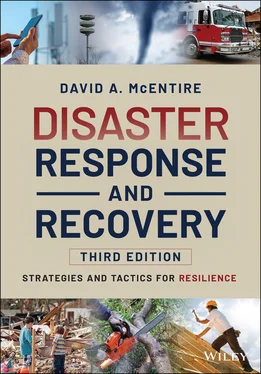The Distributed Functions of Emergency Management
Jessica Jensen, a professor and scholar at North Dakota State University, suggests that emergency management is a “distributed function.” This valuable insight implies that there are more people involved in emergency management than just the emergency manager. And, this concept also insinuates that emergency managers must rely heavily on the roles and contributions of others to accomplish their goals. With this in mind, emergency management is like a very complex network of individuals, agencies and departments as well as a myriad of actors from the private and non‐profit sectors. In other ways, emergency management is like the hub of a wheel. The emergency manager is the focal point and all of the other participants are the spokes. Whether you view emergency management as a multifaceted network or a well‐organized wheel, it is clear that emergency managers work with many individuals and organizations to promote disaster resilience.
What is the DRC typology?
What are tasks?
What are structures?
What is the difference between an established organization and an extending organization?
Can you give an example of an expanding organization?
How can the DRC typology assist you in knowing what to expect when a disaster occurs?
What is the whole community and why is this concept important?
In order to promote disaster resilience, you must be aware of each of the participants who may become involved in response and recovery operations. Local government departments and offices are public organizations that to respond to disaster. If needed, state and federal governments provide additional disaster assistance to cities and counties. A variety of services, donations and volunteers are made available by numerous corporations and non‐profit organizations (such as the Red Cross and Salvation Army). Community members—whether part of CERTs or emergent groups—also give of their time and energy to help victims affected by disasters. Awareness of the DRC typology can illustrate unique features of the organizations involved in disasters. It is imperative that you comprehend what types of conflicts may arise as multiple organizations react to disasters. It is also recommended that you also understand who in the “whole community” can help you fill your role as an emergency manager when disasters occur. By doing these things, you can take advantage of the unique talents and resources of people and organizations in order to accomplish amazing things in spite of devastating disaster impacts.
| American Red Cross |
A national member of the International Committee of the Red Cross (ICRC) and a member of the International Federation of Red Cross and Red Crescent Societies (IFRCRCS) |
| Community Emergency Response Team (CERT) |
A group of concerned citizens that receive some basic disaster training. |
| Emergency Management Assistance Compact (EMAC) |
Similar to a local mutual aid agreement but it is for states. |
| Emergent organizations |
Groups of individuals who work together to perform common goals but do not have a formalized organization (Stallings and Quarantelli, 1985, p. 84). |
| Established organizations |
Groups that perform routine tasks with existing structures. |
| Expanding organizations |
Groups that perform routine tasks with new structures. |
| Extending organizations |
Groups that perform nonroutine tasks with existing structures. |
| Faith‐based organizations |
Nonprofit groups that perform some of the same functions as other nonprofits, but they are associated with religious organizations. |
| Federal Emergency Management Agency |
Agency created in the late 1970s by President Jimmy Carter to help coordinate the activities of the government. |
| Federal government |
The national political unit that is composed of many agencies and officials. |
| Local governments |
City or county organizations that perform important public functions. |
| Mutual aid |
The sharing of personnel, equipment, and facilities. This occurs when local resources are inadequate to meet the needs of the disaster. |
| National Guard |
A reserve military unit operated under the direction of the governor. |
| National Disaster Recovery Framework |
A guide to enable effective recovery in disaster‐stricken areas. It provides disaster recovery managers with a flexible structure to restore affected communities. |
| National Response Framework |
A document that describes what the gov ernment and whole communities will do in catastrophic disasters. |
| National Volunteer Organizations Active in Disasters (NVOAD) |
An organization that brings agencies together to promote various types of assistance after disasters. |
| Nonprofit sector |
The division of society that is comprised of humanitarian, charitable religious, and voluntary organizations. |
| Points of Light |
A foundation dedicated to the promotion of volunteering. |
| Private sector |
A part of society that includes businesses and corporations. |
| Public sector |
The segment of society that is made up of government offices, departments, and agencies. |
| State government |
The political unit comprised of numerous cities and counties and includes bureaucratic agencies and politicians. |
| Tribal government |
“An Indian or Alaska Native tribe … that the Secretary of the Interior acknowledges to exist as an Indian tribe pursuant to the Federally Recognized Indian Tribe List Act of 1994.” |
| Whole community |
The idea that a “government‐centric approach to emergency management” is not sufficient to face a catastrophic disaster. All available resources must be collectively utilized at each level of government to prepare for and respond to such an incident. |
ASSESS YOUR UNDERSTANDING
Posttest to evaluate your knowledge of roles and responsibilities of disaster participants.
Measure your learning by comparing pretest and posttest results .
1 The public sector is subdivision of society made up of ordinary, everyday citizens. True or false?
2 A business would be categorized under the private sector. True or false?
3 An example of a nonprofit organization is a community‐based agency that engages in humanitarian and charitable work. True or false?
4 Mutual aid involves the sharing of first responders or necessary supplies. True or false?
5 Mayors and other elected officials are responsible for declaring a disaster at the local level. True or false?
6 State governments will not become involved in disasters but will simply request assistance from the federal government. True or false?
7 The National Guard may help conduct search and rescue missions or remove debris after a disaster. True or false?
8 FEMA is the only organization at the federal level that gets involved in disaster activities. True or false?
Читать дальше












